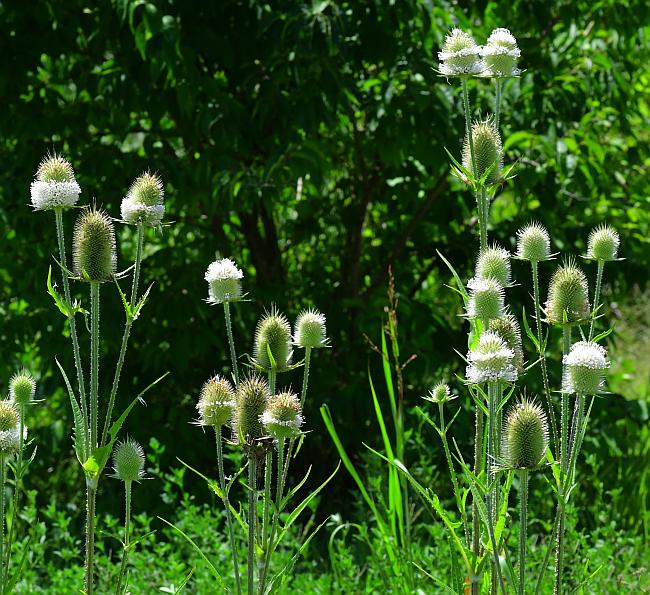Dipsacus laciniatus L.
Cut-Leaved Teasel

Introduced
CC = *
CW = 3
MOC = 38
© SRTurner
Dipsacus laciniatus L.Cut-Leaved Teasel | |
 |
Introduced CC = * CW = 3 MOC = 38 |
© SRTurner |
|
Family - Dipsacaceae Habit - Biennial forb. Stems - Erect, to 2.5 m, ridged or angled, with hooked and straight prickles, typically single from the base, branching in the apical half.
Leaves - Basal leaves irregularly pinnately lobed, oblong-lanceolate to narrowly ovate in outline, the lobes irregularly oblong, bluntly toothed or more commonly lobed again, sometimes also prickly. Stem leaves 3-50 cm long, prominently fused toward the base, forming a cuplike structure around the stem, usually somewhat folded longitudinally, irregularly pinnately lobed (the uppermost leaves occasionally entire or nearly so), oblong-lanceolate to narrowly ovate in outline, the thickened midrib prickly, the lobes irregularly oblong to linear, bluntly toothed or more commonly lobed again, sometimes also prickly.
Inflorescence - Dense terminal, dense clusters of numerous flowers, subtended by 1-2 whorls of involucral bracts, these 1.5-10.0 cm long, the longest often longer than the head, narrowly lanceolate-triangular to linear, appearing flattened in cross-section, prickly along the midrib and margins and tapered to a spinescent tip. Heads 3-10 cm long, ovoid to cylindrical-ovoid.
Flowers - Perfect, epigynous, somewhat zygomorphic, each subtended by 1 receptacular bract (this with the body lanceolate to oblongovate, tapered abruptly at the tip to a long [to 25 mm], slender, loosely ascending, spinelike awn, persistent after the fruits have been shed) and enclosed in a 4-ribbed involucel of fused bractlets (this about as long as the ovary, truncate or obscurely 4-toothed at the tip, shed with the fruit). Calyces cup-shaped, 1.2-1.6 mm long, densely hairy. Corollas 4-lobed, 12-15 mm long, the tube and lobes white. Stamens 4, exserted, alternating with corolla lobes, the anthers white. Pistil 1 per flower, of apparently 1 carpel (a second carpel aborting early in development). Ovary inferior, with 1 locule, the placentation terminal. Style 1 per flower, the stigma 1, positioned laterally at the style tip. Ovule 1.
Fruits - Achenes 4-5 mm long (including the involucel but not the calyx), linear, the involucel 4-angled, 8-ribbed, light brown. Flowering - June - September. Habitat - Roadsides, railroads, fields, fencerows, open disturbed places. Origin - Native to Europe. Lookalikes - D. fullonum. Other info. - This plant is a relatively recent introduction to the state, but is spreading aggressively along roadsides and other open areas. It is particularly prevalent in northern sections of the state but is becoming more and more common elsewhere. The plant is easily identified to genus by its distinctive flowering heads. Features which distinguish this species from D. fullonum include flowers which are white rather than lavender in color, involucreal bracts which spread outward rather than curving up, and lower leaves which are irregularly and deeply incised on the margins. Photographs taken off Hwy 60, Shannon County, MO., 8-11-03 (DETenaglia); also near Allenton, St. Louis County, MO, 7-29-2020 (SRTurner). |